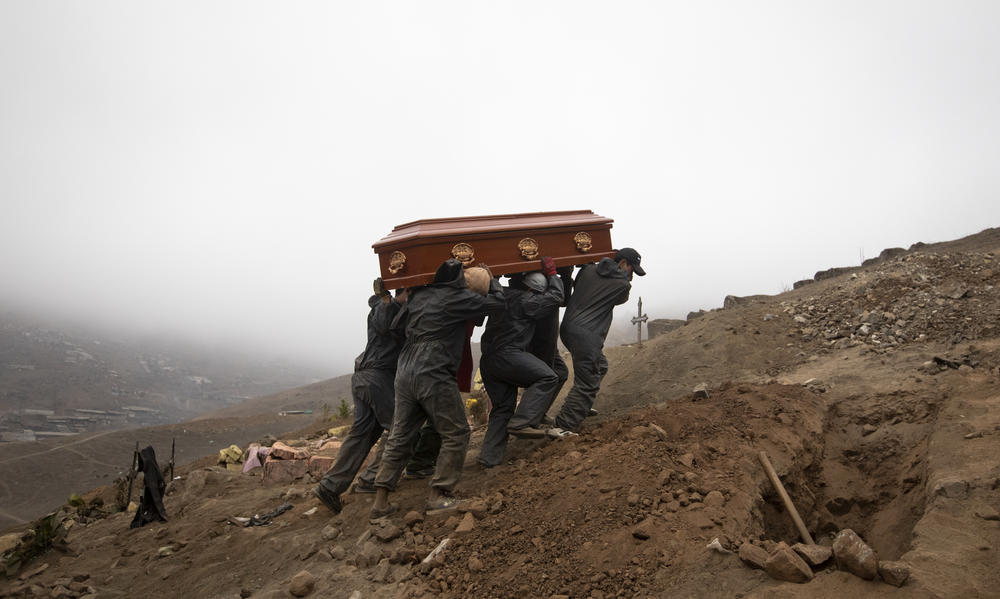Loading...
Section Branding
Header Content
Chart: COVID-19 Is Now Leading Killer In 5 Latin American Nations
Primary Content
COVID-19 has become the leading cause of death in five Latin American nations and the second most common cause in six others. The World Health Organization's "Americas Region," which stretches from the Canadian Arctic to Cape Horn in Chile, has been hit harder by the pandemic than any other part of the globe. The region currently accounts for 48% of the 1.65 million COVID-19 deaths reported to WHO so far worldwide.
While the United States is a major contributor to that trend with more than 300,000 deaths, Peru's death rate from the disease is actually higher than the U.S.
COVID-19 now surpasses coronary heart disease as the No. 1 cause of death in Brazil, Chile, Ecuador and Panama.
In an NPR analysis of global data, Belgium is the only country in the world outside Latin America where COVID-19 has established itself as the top killer. This comes from comparing COVID-19 deaths so far in 2020 with annual data on causes of death from 2019. Across the Americas, hospitals and cemeteries have been strained.
Even the traditional visits to cemeteries on All Saints' Day — at the end of October — were put on hold. It's a time when people bring flowers, food and freshly baked loaves of bread to honor their departed loved ones, particularly the recently deceased.
But this year on All Saints' Day in Peru, police and soldiers in riot gear blocked the gates of three cemeteries on the outskirts of Lima to prevent possible coronavirus spread from the influx of visitors. "The pandemic has hit us hard," Comas Mayor Raúl Díaz Pérez said on a video posted on his Facebook account. Standing in front of lines of officers at the entrance to the cemetery La Balanza, he said: "We are calling on the people to have patience and at this time to do not come to the cemeteries to visit your loved ones." He urged: Don't show up with the band you may have hired and the food you may have prepared to say goodbye to a newly departed family member.
The fact that COVID-19 has hit Latin America harder than other regions isn't a fluke. The continent had all of the ingredients to ignite a pandemic — crowded living conditions, poverty, social discord, poor governance and fragmented/underfunded health systems.
The coronavirus has exacerbated longstanding problems, says Carissa Etienne, the head of the Pan-American Health Organization, the World Health Organization's regional office for the Americas. "Latin America is one of the most unequal regions of the world," Etienne said this week in a video call with reporters.
The virus swept through dense urban metropolises such as Mexico City, Bogotá and São Paulo, where physical distancing was difficult if not impossible.
"The many millions who rely on the informal economy for their livelihoods didn't have the option to stay home," Etienne said. "And for people living in marginalized settings and remote areas — like our indigenous communities and migrants — proper health care was often out of reach."
In addition, Latin American countries have high levels of obesity, diabetes and other underlying chronic health conditions that have made the virus far more deadly.
Jeremy Veillard is a senior health specialist with the World Bank specializing in Latin America.
"In Peru, which is one of the countries where you have had the highest number of excess deaths from COVID-19, 85% of the people who died from COVID-19 during the summer were either overweight or obese," Veillard says.
Another factor in Latin America is the hodgepodge of ways that people access health care in the region. Some go to private clinics and hospitals. Some rely on government programs. Some visit a doctor at a pharmacy only once they're sick. These siloed systems offer dramatically different levels of service to residents based on what — if anything — they're able to pay.
"In Latin America and the Caribbean, there are very fragmented [health care] systems," says Frederico Guanais, deputy head of the health division of the Organisation for Economic Cooperation and Development.
Guanais, who's originally from Brazil, says this patchwork of health care options is far more complicated than just one public system and one private system: "Oftentimes there's one health system that aims to be universal. Then there are subsystems in some countries that cater to those who have formal employment. There's another subsystem for those who do not have formal employment. And yet another system for those who can pay supplemental health insurance."
Each system may have different sets of staff, policies and hospitals, which is not ideal when national health authorities are trying to steer them in unison to address a health crisis.
There are also mismatches in resources.
"In Brazil, the publicly funded health system has roughly 40% of the country's ICU [intensive care unit] beds," Guanais says. The other 60% of Brazil's ICU beds, he says, are in private hospitals that serve less than 25% of the population.
So while Brazil has top-notch medical facilities, they aren't readily accessible to the masses.
The country's structural inequity can mean that for Brazilians with limited resources, a severe case of COVID-19 could be potentially fatal, while it might not have been if they lived somewhere else. And this is part of why COVID-19 is now the leading cause of death in the region, says Guanais.
Copyright 2020 NPR. To see more, visit https://www.npr.org.

